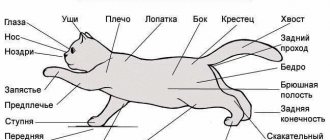The Javanese cat will definitely captivate you with its beauty and elegance. In the world she is considered unusual and beautiful, due to her beautiful eyes and the variety of shades of fur. Although the breed is young, it will definitely give you a chance to take a look and understand that the Javanese cat is exactly what you dreamed of.
Javanese has a mystical look and unusual appearance that makes you dream about this cat.
History of the Javanese cat breed
Many principles revolve around this story, and it is still a little unclear who first invented such a miracle of nature. It is known that there are two varieties of this breed. There is an American type and a European one. Although they are different, it will be difficult for a non-specialist to notice the differences between them.
And yet, the American type was developed in North America thanks to two girls, Ann Sendner and Maureen Davis. They wanted a Balinese cat with different types of colors. Therefore, we crossed a Siamese and a Balinese cat, adding a pinch of shorthaired oriental colorpoint. So, in 1978, the first Javanese cat was born. In 1979, she already received her recognition from American organizations.
The European type appeared in Great Britain thanks to the crossing of a Siamese with an Abyssinian. At first she took the name of the British Angora. But later, in order to avoid confusion, they decided to rename it Javanese. In Europe, it began to be bred en masse much later than in America.
In Russia this breed is very rare and it will be difficult to take such a cat home. You may not find it.
It is an interesting coincidence that two countries decided to breed the same cat.
Where to buy
Russian nurseries started actively producing Javan kittens only a few years earlier. In the capital you can buy a young Javanese, for example from.
This breed is not bred in Ukraine. There is only a Sevastopol breeder of Balinese dogs. In Belarus the situation is the same, there is only the Brest nursery of Balinese. Having decided to purchase a Javanese from an advertisement, you need to find out how they speak about the owner.
Popular kennels for this breed:
- Russia - (your nursery is here);
- Belarus - (take place);
- Ukraine - (submit an application).
Appearance
The appearance of the Javanese is very interesting, and looking at this cat, you want to study its distinctive parts of the face and body.
Javanese weight is 3–5 kg. Height at the withers is 21–25 cm.
| Head | Wedge-shaped and narrow. Resembles an exact triangle. The muzzle is flat, without dents or bulges. |
| Eyes | Almond-shaped, slightly oblique. The color is either blue or green. |
| Ears | Large, wide. They taper towards the tip. |
| Nose | Straight and flat. Long. |
| Body | Medium build, slightly elongated. Sleek and muscular. Some areas are tightened. Cats are a bit skinny. The neck is elongated. |
| Paws | Long, strong and flexible. The hind ones are longer than the front ones. The paws are round. |
| Tail | Long and thin. It's fluffy, even though there's no undercoat there. |
| Wool | Not long, no undercoat. Fine hairs. Fits tightly to the body, silky and soft. |
Thanks to the straightness of their nose, these cats are considered the best in the world.
Description of the breed
The Javan cat appears thin and fragile, although in fact it is a strong animal with muscles of steel, weighing up to 5 kilograms. A long slender body, high limbs with small graceful oval-shaped paws, a flexible tail that can bend in the most bizarre way are the characteristic features of this breed.
The Javanese's head, especially its elongated muzzle, resembles one of the wild relatives of our pets - a puma or a jaguar. Developed cheekbones, a sharp chin and a wide nose without a pronounced bridge of the nose especially contribute to this impression.
The ears of the Javanese are large, tapering upward, set wide apart, sloping to the sides.
The eyes are expressive, slanted, most often emerald green or golden green in color. Animals with white fur may have blue or light blue fur.
The long tail resembles a beautifully feathered feather, wide at the base and smoothly tapering at the tip.
The Javanese's coat is thin, smooth as silk, and completely devoid of undercoat. The belly and tail are more furry than other parts of the body, and the hair on them is longer.
Variety of colors
Javanese have many colors, because that’s what they were bred for. Therefore, you will be faced with a huge selection of shades.
- Solid shade - pure white, black, gray, brown.
- Red tint - with a tint of red color. The nose and pads are red.
- The lilac shade is a silvery color that smoothly turns into pink.
- Blue is a gray color that smoothly turns into blue.
- Cream shade - sand color, very delicate color.
- Chocolate color is a brown color in which there are transitions to red.
- Tabby (color with markings) is a marbled shade. It includes: tortoiseshell (torti), tiger, tikir.
- Bicolor – uniform tones with spots, Siamese, smoky and tortoiseshell.
And this is only part of the colors. These flowers produce other varieties that have a different name.
There are high requirements for color, so there are many nuances when breeding new cats.
Character
By crossing two different cats, the result was a Javanese with an interesting twist in character.
The Javanese is a stubborn cat who likes to be on her own and have control in her paws. They don’t miss a single party, so they are very active. They love to jump, run and play. Very restless. Therefore, they will definitely find a common language with children and other animals. They will not conflict with them, but they can release their claws.
Insanely curious and unusually smart. It may seem that two traits such as a combustible mixture do not suit each other. But no. Thanks to their curiosity and intelligence, they will not hesitate to open a closet or climb into a closed room. They have a good memory, so be careful to hide items that you are very worried about. Because if she couldn’t get into the closet today, she will do it in a month.
Also, according to the description of the owners, Javanese are excellent hunters and will every time bring rats and mice in their teeth, if any. You can teach them a couple of commands that they can easily learn. They always know the daily routine in the house and their place.
They are very loyal to their owner and will follow their heels until the end of their days, seeking affection and attention. They don’t like loneliness, but if they have to face it, they will be able to occupy themselves so that the time passes faster. They talk constantly, even when you contact them, they will definitely answer you with a meow. Therefore, noise, disorder and peace will always be present in your home.
Although they easily become attached to the house and owner, they still calmly endure moving.
Temperament and habits
Javanese are very affectionate, they are devoted to their owners and love to follow them. They also love to be held in arms and sleep on the same bed with their owners. They may not be as noisy as Siamese cats, but they are just as persistent. They crave attention and want to be in control.
Javanese pets are very intelligent, agile and physically resilient. Fluffy babies love to fuss, climb trees or scratching posts. A grown-up animal can be taught to go for a walk in a harness, and also perform simple tricks.
A Javanese cat must always have cat toys at his disposal, otherwise he can create a mess in the house. The Javanese are definitely not suitable for people who are phlegmatic and overly scrupulous about order.
The Javanese thrives alone, but thoroughly enjoys time with its owner. To keep your pet from getting bored, you can get another one, but then the house will be a mess.
Conditions of detention
You should not have a Javanese cat in an apartment, especially in a one-room one. They will be very cramped, and they will definitely turn everything upside down.
The best option is a large private house. There is a lot of space there, the cat will definitely throw out all its energy. A plus would be going out into the yard, where the cat can take a walk and frolic.
The cat must be left with toys, otherwise the cat will play with your things. At best, buy a large play area with stairs and floors. It is a fact that Javanese are sporting cats and they love such areas. You can stock up on intellectual toys.
Walking on a leash is allowed, but it is better to teach this from early childhood so that it does not become a shock for the cat.
For people who do not like noise and disorder, such a cat is definitely not suitable.
Care instructions
The Javanese cat breed does not require a lot of care, but classic procedures still need to be carried out.
- Grooming. Cats have no undercoat, so they are long and thin. You don’t have to worry too much about this, just brush it once a week with a special brush. Bathing should not be frequent, because the dry skin of the Javanese is very sensitive. They themselves take care of the cleanliness of their fur coat and skin. You can wash your cat a couple of times a year, but use shampoo for fine fur. Although shedding occurs, it is not in huge quantities.
- Ear care. Wide ears and endless curiosity pollute the pet’s ears, so two to three times a week you need to wash the ears with a swab soaked in peroxide or chlorhexidine.
- Eye care. Also wipe the eyes with a moistened swab. You can use tea or chamomile, and there are also special remedies for such cases.
- Claw care. A scratching post in the house definitely wouldn’t hurt, but sometimes you have to keep an eye on your claws. Once a month you can trim it, but you need to do it correctly and with special scissors, which are sold in a pet store.
- Dental care. Cats also need to brush their teeth because they don’t know how to do it themselves. Buy a special brush and toothpaste for cats and brush their teeth once a week.
Before you bring a kitten into your home, you should buy everything you need for life in advance.
Education and training
The Javanese is an extremely intelligent breed that is easy to train. Such a pet can be easily taught basic commands if desired. Of course, a cat is not a dog and it will never walk on a line, but bringing you slippers or raising a voice is a piece of cake.
Javanese cats are very obedient in terms of training. They easily get accustomed to the tray and scratching post. You are unlikely to have to punish your pet strictly, since the Javanese are not prone to pranks. Provided, of course, that he has enough space to play and the attention of his owners.
Catering
For nutrition, you can choose two ways: natural homemade ingredients or premium dry food. You should not overfeed your pet, as they tend to become overweight.
If you decide to feed your cat exclusively food with vitamins and macroelements, then you should choose food that contains zinc and vitamin B.
For natural nutrition you need:
- Lean meat (poultry, rabbit, beef, veal)
- Fermented milk products (kefir, cottage cheese, sour cream, fermented baked milk, yogurt, milk)
- Fish (hake, trout, salmon)
- Eggs (quail, boiled chicken yolk)
- Vegetables (pumpkin, carrots, beets, zucchini, greens, broccoli, asparagus, lettuce)
- Cereals (oatmeal, buckwheat, rice)
Meat and cereal porridge should be given daily. Water is always available.
Kittens are fed 6 times a day, adult cats and cats 2 times a day.
Yavnezov should be strictly kept on a low-calorie diet.
Diseases
They live a long time, about 13–15 years. But, Javanese cats are susceptible to genetic diseases that come from their ancestors. Not everyone inherits them, but those who do have it will have a very hard time, because many of them are incurable and serious.
- Asthma. In such cases, a complete cure is not possible, but only suppression of symptoms. An inhaler is purchased for asthma attacks; the air must always be clean and humid.
- Epilepsy. It is also an incurable disease associated with negative brain functions. The cat may faint or stare at one point. The use of drugs relieves the severity of symptoms.
- Hyperthyroidism. The disease comes from the thyroid gland. There is treatment: you need potassium and a corticosteroid. In this case, there are a lot of symptoms: frequent urination, hair loss, tremors, apathy, lethargy.
- Amyloidosis. An incurable disease, symptoms can be reduced with medications. Lack of appetite, thinness, constipation, diarrhea, apathy and others.
- Myasthenia. Weakening of muscles due to dysfunction of the nervous system. Treatment is possible with medications or surgery.
- Problems with the digestive system. In this case, you should feed your pet properly so that such problems do not arise.
Rarely, kittens may have congenital hearing problems.
Health
From its ancestors, the Javanese cat received a tendency to certain hereditary diseases, so it is necessary to carefully monitor its health. The main problems are typically ocular: strabismus and nystagmus. There are disturbances in the functioning of the respiratory and cardiovascular systems. In the first case, it is a tendency to asthma. In the second - heart defects and other concomitant diseases.
Amyloidosis, a disorder of protein metabolism, also occurs. Stressful conditions provoke neuroses. That is why regular visits to the veterinarian should not be neglected. Vaccination and deworming are mandatory. With proper care and attention, their life expectancy is on average up to 15 years.
Breeding Javanese
If you decide to start breeding, then know that in Russia this breed is rare and not all people do it. It will be difficult to find a partner and a buyer.
When choosing a partner, look at his pedigree and find out what diseases he was susceptible to.
As soon as you notice a male, take care of the cat, trim its claws and bring it to the cat's territory.
It is better to breed a cat for the first time when she has already reached the age of one year. Before this period, you should not breed, because the cat itself has not yet fully formed and it is not a fact that it can bear healthy offspring. The best time for mating is two years of age.
You can give birth once every 2 years so that the cat’s body recovers after childbirth. But some people knit a cat 5 times a year, holding the opinion that this is how nature intended
Before you decide to give your cat the freedom to give birth, you need to learn all the intricacies of this matter. If you are not careful, you may end up with a kitten with a defect or health problems.
Exterior standard
Javankas have small parameters, their mass varies in the range of 2.5-5 kilos. The breed standard is the same for Javanese and Balinese dogs; differences are observed only in color.
Detailed characteristics of the appearance of the Javanese, approved by the association of felinologists CFA:
- The body is not very large, elongated and graceful. A strong physique and well-developed muscles are harmoniously combined.
- The neck is elongated.
- The shoulder girdle and pelvic area complement the graceful contours of the torso. The first should not be narrower than the last.
- The press is toned.
- The limbs are elongated and slender, the forelimbs are shorter.
- The tail is elongated, thin, becoming even thinner at the end. The tail edge resembles a feather.
- The fur is not very long, the longest is on the tail. The fur is thin and silky. There is no undercoat.
- The head is oblong, narrow, wedge-shaped, not very large, in harmony with the body. If you smooth out the fur on the muzzle, the structure of the skull will become obvious. If you look from the side, you can clearly see a straight stripe from the top of the head to the nose, that is, the eyebrows are not bulging and the bridge of the nose is not sunken. The end of the chin is on the same vertical segment with the mirror of the nose.
- The ears are very large, pointed, widened at the base, complementing the wedge-shaped structure of the head.
- The eyes are not very large, resembling almonds, not protruding, but not deep either. Located at an angle to the nose, harmoniously combined with the contours of the head wedge and ears.
- They have bright heavenly colors.
- The nose is elongated and smooth.
How much does a Javanese cat cost?
Typically, Javanese cats are purchased for participation in exhibitions, so the price is much higher.
The price ranges from 15 – 100 thousand rubles. Naturally, the most expensive cat is the owner of the highest class, with a good pedigree.
In order to purchase a cat of this breed in Russia, it is worth traveling around Mother Earth. Nurseries are located only in Yekaterinburg and Chelyabinsk. And the nearest nursery abroad is in Ukraine and Belarus.
By purchasing a kitten, you become the owner of a ringing laugh, amazing stories and a wonderful cat. Take a look at the photos and there will be no turning back.
Character and family attachment
In their devotion, Javanese cats differ from most cats - they are freedom-loving and independent. Their attachment to the family is very high. As a rule, they choose one person as their “favorite” and follow him like a thread following a needle. Javanese cats are stubborn, love attention very much, want to “personally” take part in all events, in other words, they claim to be the “center of the Universe” in a single “cell of society.”
Javanese cats are similar to dogs in their playfulness. They can be called real “energizers”. They love to jump, climb somewhere, and play with objects that fall into their paws. The Javanese's antics are inexhaustible, and their tricks are unpredictable, because they are also incredibly smart. The play potential of this breed is so great that they must be purposefully occupied with the help of special “simulators” in an impromptu sports corner, otherwise the mischievous purrs will turn the whole house upside down. Javanese get along well with their relatives and turn them into entertainment partners. This must be taken into account if you want to have several animals “so that they don’t get bored.” They definitely won’t be bored together, but they will cause a lot of trouble with their antics.
Two Javanese kittens
Javanese cats willingly play with both children and teenagers and are tolerant of children if they do not perceive the pet as a toy. The proud “mustachioed-tailed ones will not allow” squeezing and tugging and can show aggression, although within reason. The reaction to strangers is generally positive if they do not show aggression.











